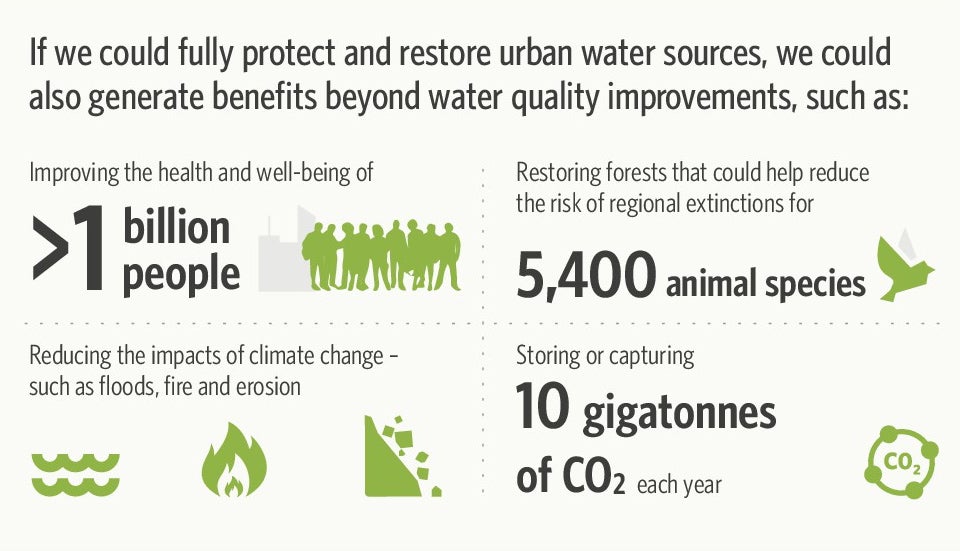The journey of our water from source to tap is long, and not one we think much about. For most of us, our water starts high in the mountains, hundreds of miles away. From there, water flows across natural and working lands until a portion is channeled to water pipes that move water to our faucets, to farms, and to various types of businesses. Most often we think of those pipes as being our main water infrastructure, but upstream lands play a key role in capturing, storing and moving our water. By conserving these lands, we can better protect our water and generate additional benefits for people and nature.
Today, approximately 40 percent of the land in urban source watersheds of the world’s largest cities show high to moderate levels of degradation. This degradation impacts the present and future quality and reliability of water flows . However, by investing in nature, we can reduce these impacts.

A new report released by The Nature Conservancy, Beyond the Source: The environmental, economic and community benefits of source water protection, shows that forest protection, reforestation, and the use of cover crops can help four out of five of the 4,000 cities analyzed reduce sediment and nutrient pollution in waterways by a meaningful amount.
For one in six cities analyzed in the report, the cost of implementing source water protection activities could be recouped through savings in annual water treatment costs alone. For half of the cities analyzed, these activities could be implemented for about US$2 per person annually.
These nature-based solutions also provide a number of co-benefits, including improving the health and well-being of people, preserving biodiversity, capturing and storing carbon and building more climate-resilient communities. When cities “stack” the value of these co-benefits on top of the savings realized in water treatment costs, they can derive even greater value.
Maximizing the benefits of conservation activities will require collective action . Water funds, which enable downstream water users to jointly invest in upstream land conservation and restoration, are a successful mechanism for securing improved water quality and, in some cases, more reliable flows.

For example, in Nairobi, Kenya, high sediment levels in the Tana River from agricultural run-off and development in the mountains catalyzed the development of Africa’s first water fund. Partners in the Upper Tana-Nairobi Water Fund jointly invest in providing upstream farmers with the training, resources and equipment they need to help keep the river healthy, conserve water and reap the benefits of higher crop yields and more stable farms. The fund also has downstream projected benefits including improved water yields and reduced sediment in the river. An analysis of the water fund structure showed that even by conservative estimates, the selected watershed interventions could deliver a two-to-one return on investment on average over a 30-year timeframe. During a recent trip to Kenya, the message from water fund investors and participants was clear: it's in their best interest to make this work. Taking care of the land will ensure the longevity of the agricultural community and create a more sustainable water future throughout the watershed.
As cities and populations grow, and climate change adds undue pressure on vulnerable freshwater systems, maintaining healthy lands around our water sources will be increasingly vital to the future of our water security. By investing in nature, we also invest in our future.
Download the report at nature.org/beyondthesource or visit www.protectingwater.org to explore the data using an interactive map.
*The views expressed in this blog are those of the author alone. Publication does not imply endorsement of views by the World Bank.*


Join the Conversation